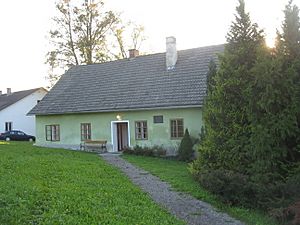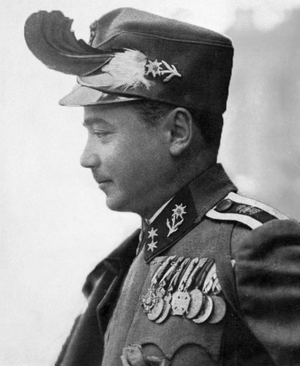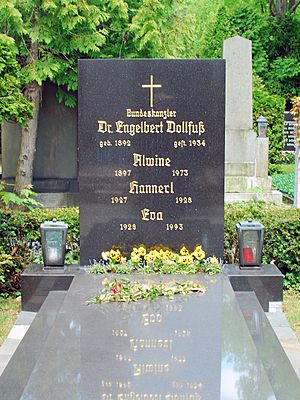Engelbert Dollfuss facts for kids
Quick facts for kids
Engelbert Dollfuss
|
|
|---|---|
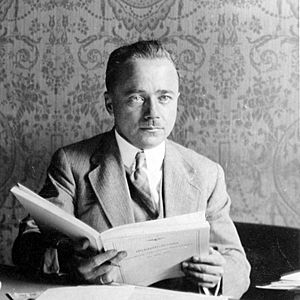
Engelbert Dollfuss c. 1930
|
|
| Chancellor of Austria | |
| In office 20 May 1932 – 25 July 1934 |
|
| President | Wilhelm Miklas |
| Vice-Chancellor | Franz Winkler Emil Fey Ernst Rüdiger Starhemberg |
| Preceded by | Karl Buresch |
| Succeeded by | Kurt Schuschnigg |
| Leader of the Fatherland Front | |
| In office 20 May 1933 – 25 July 1934 |
|
| Preceded by | Party established |
| Succeeded by | Ernst Rüdiger Starhemberg |
| Minister of Foreign Affairs | |
| In office 20 May 1932 – 10 July 1934 |
|
| Preceded by | Karl Buresch |
| Succeeded by | Stephan Tauschitz |
| Minister of Agriculture and Forestry | |
| In office 18 March 1931 – 25 June 1934 |
|
| Preceded by | Andreas Thaler |
| Succeeded by | Ernst Rüdiger Starhemberg |
| Personal details | |
| Born | 4 October 1892 Texing, Lower Austria, Austria-Hungary |
| Died | 25 July 1934 (aged 41) Vienna, Austria |
| Cause of death | Assassination |
| Resting place | Hietzinger Cemetery, Vienna, Austria |
| Political party | Fatherland Front (1933–1934) |
| Other political affiliations |
Christian Social Party (until 1933) |
| Spouse | Alwine Glienke |
| Alma mater | University of Vienna |
| Cabinet | Dollfuss I-II |
| Military service | |
| Allegiance | Austria-Hungary |
| Branch/service | Austro-Hungarian Army |
| Years of service | 1914–1918 |
| Rank | Oberleutnant |
| Unit | Kaiserschützen |
| Battles/wars | |
| Awards | Military Merit Cross 3rd Class Military Merit Medal (2 times) Medal for Bravery Karl Troop Cross (2 times) Wound Medal |
Engelbert Dollfuss (born October 4, 1892 – died July 25, 1934) was an important Austrian politician. He served as the leader of Austria, known as the Chancellor, from 1932 to 1934. Before becoming Chancellor, he was the Minister for Forests and Agriculture.
Dollfuss became Chancellor during a difficult time for Austria's government. In 1933, the Austrian parliament faced a crisis and could no longer function. Dollfuss then took strong control of the government. He stopped the Socialist movement in 1934 during the Austrian Civil War. He also banned the Austrian Nazi Party. He created a new type of government based on strong, conservative rule. This was called the First of May Constitution.
Sadly, Dollfuss was killed in 1934 during a failed attempt by Nazi agents to take over the government. His successor, Kurt Schuschnigg, continued his style of rule until Adolf Hitler took over Austria in 1938.
Contents
Early Life and Education
Engelbert Dollfuss was born into a poor farming family in a small village in Lower Austria. He spent his childhood in his stepfather's home and went to elementary school there. Local priests helped pay for his education because his family could not afford it. He went to high school in Hollabrunn.
After high school, Dollfuss first wanted to become a priest. He started studying theology at the University of Vienna. However, after a few months, he changed his mind and began studying law in 1912. To support himself as a student, he gave lessons. He also joined a student group that helped workers and did charity work.
Dollfuss in World War I
When World War I started, Dollfuss tried to join the army in Vienna. He was rejected because he was too short. He was less than 5 feet tall. People later nicknamed him "Millimetternich," which combined "millimeter" (a tiny measurement) with the name of a famous, powerful politician, Klemens von Metternich.
The same day he was rejected, Dollfuss went to another recruiting office in Sankt Pölten. He insisted on joining and was accepted, even though he was still too short. As a volunteer, he chose to serve in the Tyrolese militia, known as the Kaiserschützen. He quickly became a corporal. He fought for 37 months on the Italian Front, in the southern part of Tyrol. By 1916, he was promoted to lieutenant.
After the War and Early Career
After the war, Dollfuss was still a student. He got a job with the Lower Austrian Peasants' Union. This job helped him financially and gave him his first experience in politics. He helped farmers recover from the war and protected them from certain political ideas.
Because of his skills, he was sent to Berlin for further studies. There, he focused on Christian ideas about economics. He also gained practical experience working for a bank that helped farmer cooperatives. In Germany, he met his future wife, Alwine Glienke.
After returning to Vienna, he became a secretary for the Lower Austrian Peasants' Union. He worked hard to strengthen the farming industry. Dollfuss helped create the regional Chamber of Agriculture of Lower Austria. He also helped organize new farming policies. He became known internationally for his ideas about agriculture. Many saw him as an unofficial leader for Austrian farmers.
In 1930, Dollfuss became the president of the Federal Railways, which was Austria's largest industrial company. This job connected him with many different industries. In March 1931, he was appointed Federal Minister of Agriculture and Forestry.
Becoming Chancellor of Austria
On May 10, 1932, Dollfuss was offered the job of Chancellor by President Wilhelm Miklas. Dollfuss was 39 years old and had only one year of experience in the government. He spent the night praying before accepting the offer.
Dollfuss was sworn in on May 20, 1932. He led a government made up of several parties: the Christian-Social Party, the Landbund (a farming party), and the Heimatblock (a group linked to a paramilitary force). This new government faced the huge challenge of dealing with the Great Depression. Austria had lost much of its industry after World War I. This made the country economically weak.
Dollfuss's government had a very small majority in Parliament, with only one more vote than the opposition.
Dollfuss's Rule in Austria
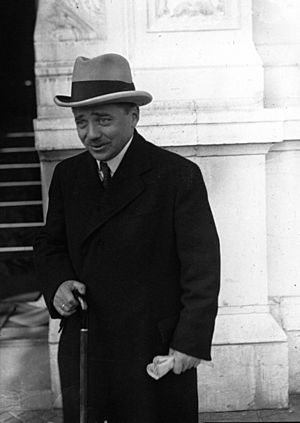
Taking Stronger Control
In March 1933, a problem arose in the Austrian parliament. The president of the lower house, Karl Renner, resigned so he could vote. Then, the two vice presidents also resigned to vote. Without a president, the parliament could not finish its meeting.
Dollfuss used these resignations as an excuse to say that the parliament could no longer work. He told President Wilhelm Miklas to close it down indefinitely. When parliament members tried to meet again, Dollfuss had police block the entrance. This effectively ended democracy in Austria. From then on, he ruled as a strong leader using emergency decrees.
Dollfuss was worried about the rise of German National Socialist leader Adolf Hitler in Germany. He feared that the Austrian Nazis could gain power in future elections. He also saw the growing influence of the Soviet Union in Europe. Because of these fears, Dollfuss banned the Communist Party of Austria in May 1933. He then banned the Austrian Nazi Party in June 1933.
He later created a one-party government under the Christian Social Party. This government was similar to the fascist rule in Italy. He banned all other Austrian parties, including the Social Democrats. However, the Social Democrats still existed as a group, though their armed group, the Republikanischer Schutzbund, was banned.
Austrofascism and Alliances
Dollfuss created a political system called Austrofascism. It was based on Catholic ideas and was similar to Italian fascism. He did not want Austria to unite with Germany as long as the Nazis were in power there. In August 1933, Benito Mussolini of Italy promised to protect Austria's independence. Dollfuss and Mussolini exchanged secret letters about how to keep Austria independent. Mussolini wanted Austria to be a barrier against Nazi Germany. Dollfuss believed that Austrofascism and Italian fascism could fight against the powerful ideas of Nazism and Communism in Europe.
In September 1933, Dollfuss combined his Christian Social Party with other nationalist and conservative groups. They formed the Vaterländische Front. This group included many workers who were unhappy with the socialist party. Dollfuss survived an assassination attempt in October 1933 by a young man who had been kicked out of the military for his Nazi views.
The Austrian Civil War
In February 1934, government forces arrested Social Democrats and searched for weapons belonging to their outlawed group. The Social Democrats called for resistance against the government. This led to the Austrian Civil War, which lasted from February 12 to February 27.
Heavy fighting happened mainly in eastern Austria, especially in some parts of Vienna. There were large, fortress-like buildings where many workers lived. Fighting also occurred in the industrial areas of Styria. Nazi agents were interested in causing conflict between the government and workers. The government used police and military power to stop the resistance. The Social Democrats were outlawed, and their leaders were arrested or fled the country.
A New Constitution
In April 1934, Dollfuss held a special parliamentary meeting with only his party members present. They approved his new constitution. This constitution was one of the first in the world to use "corporatist" ideas, similar to Portugal's. This meeting made all the decrees Dollfuss had passed since March 1933 legal. The new constitution took effect on May 1, 1934. It removed the last parts of democracy from Austria and ended the system of the First Austrian Republic.
Assassination
Engelbert Dollfuss was killed on July 25, 1934. Ten Austrian Nazis broke into the Chancellery building, where the Chancellor works, and shot him. This was part of a failed attempt to overthrow the government.
About 500,000 Austrians, out of a population of 6.5 million, attended Dollfuss's funeral in Vienna. He is buried in the Hietzing cemetery in Vienna, next to his wife Alwine Dollfuss and two of his children. His wife and children were in Italy visiting Rachele Mussolini when he died. Mussolini himself was very sad about Dollfuss's death.
In Literature
In Bertolt Brecht's 1941 play The Resistible Rise of Arturo Ui, Engelbert Dollfuss is shown as a character named "Dullfeet".
See also
 In Spanish: Engelbert Dollfuss para niños
In Spanish: Engelbert Dollfuss para niños


